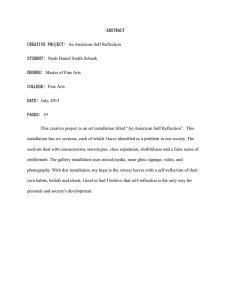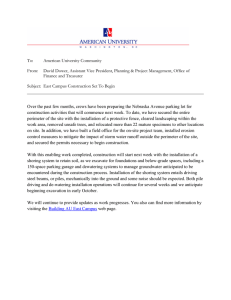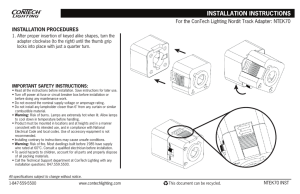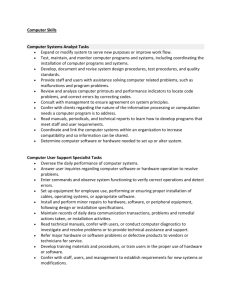AGAIN AND AGAIN by Sukha Worob
advertisement
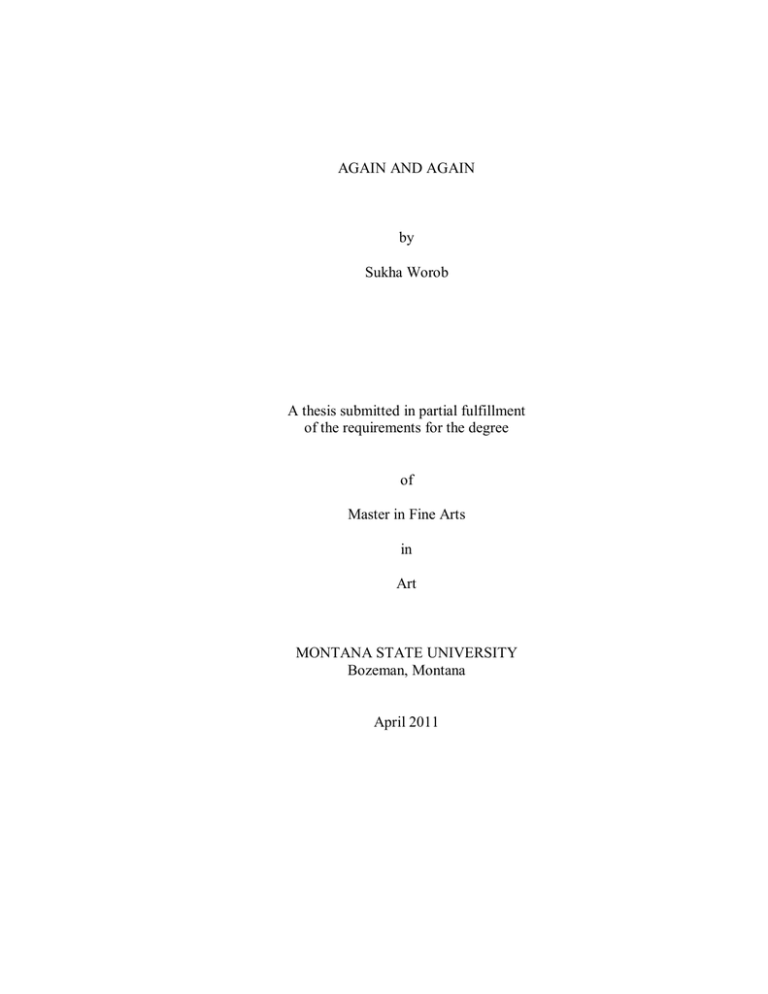
AGAIN AND AGAIN by Sukha Worob A thesis submitted in partial fulfillment of the requirements for the degree of Master in Fine Arts in Art MONTANA STATE UNIVERSITY Bozeman, Montana April 2011 ©COPYRIGHT by Sukha Worob 2011 All Rights Reserved ii APPROVAL of a thesis submitted by Sukha Worob This thesis has been read by each member of the thesis committee and has been found to be satisfactory regarding content, English usage, format, citation, bibliographic style, and consistency, and is ready for submission to The Graduate School. Gesine Janzen Approved for the School of Art Vaughan Judge Approved for The Graduate School Dr. Carl A. Fox iii STATEMENT OF PERMISSION TO USE In presenting this thesis in partial fulfillment of the requirements for a master’s degree at Montana State University, I agree that the Library shall make it available to borrowers under rules of the Library. If I have indicated my intention to copyright this thesis by including a copyright notice page, copying is allowable only for scholarly purposes, consistent with “fair use” as prescribed in the U.S. Copyright Law. Requests for permission for extended quotation from or reproduction of this thesis in whole or in parts may be granted only by the copyright holder. Sukha Worob April 2011 iv LIST OF IMAGES Images Page 1. Again and Again, 2011, Ink on wall, 40' x 12' .................................................. 9 2. Again and Again (Detail) ................................................................................. 9 3. Again and Again (Detail) ............................................................................... 10 4. Again and Again (Detail) ............................................................................... 11 5. Again and Again (With Rockers, Detail). ....................................................... 12 6. Again and Again (Post Collaboration, Detail) ................................................. 13 7. From Then Until Now, 2011, Ink on Wall, 36' x 6' ......................................... 14 8. From Then Until Now (With Rockers, Detail) ................................................ 14 9. From Then Until Now (Detail) ....................................................................... 15 10. From Then Until Now (Detail) ..................................................................... 16 11. From Then Until Now (Post Collaboration, Detail)....................................... 17 12. From Then Until Now (Post Collaboration, Detail)....................................... 18 13. Rockers (Back, Detail) ................................................................................. 19 14. Rockers (Front, Detail) ................................................................................. 20 15. Rockers (Installation, Detail) ........................................................................ 20 16. Always With Me, 2011, Layered Waxed Digital Prints on Pine Shelf, 9' x 12" (Installation View) ............................................................................................. 21 17. Always With Me (Post Collaboration, Installation View) ............................. 21 18. Always With Me (Detail) ............................................................................. 22 19. Always With Me (Detail) ............................................................................. 23 v LIST OF IMAGES – CONTINUED Images Page 20. Always With Me (Detail) ............................................................................. 24 21. Always With Me (Detail) ............................................................................. 25 22. Always With Me (Detail) ............................................................................. 26 23. Always With Me (Detail) ............................................................................. 27 24. Always With Me (Detail) ............................................................................. 28 25. Always With Me (Detail) ............................................................................. 29 26. Follow Me V.2, 2010, Monoprint, 7' x 50" (Installation View) ..................... 30 27. Follow Me V.2 (Post Collaboration, Installation View) ................................ 31 28. Follow Me V.2 (Detail) ................................................................................ 32 29. Follow Me V.2 (Detail) ................................................................................ 33 30. Follow Me V.2 (Detail) ................................................................................ 34 31. Follow Me V.1, 2010, Trace Monotype, 9' x 60" (Installation View) ............ 35 32. Follow Me V.1 (Post Collaboration, Installation View) ................................ 36 33. Follow Me V.1 (Post Collaboration, Detail) ................................................. 37 34. Follow Me V.1 (Detail) ................................................................................ 38 35. Follow Me V.1 (Detail) ................................................................................ 39 36. Follow Me V.1 (Detail) ................................................................................ 40 37. Just Noise, 2011, Intaglio Mounted on Panel, 11' x 48" ................................ 41 38. Just Noise (Post Collaboration, Installation View) ........................................ 42 39. Just Noise (Post Collaboration, Detail) ......................................................... 43 vi LIST OF IMAGES – CONTINUED Images Page 40. Just Noise (Detail) ........................................................................................ 44 41. Just Noise (Detail) ........................................................................................ 45 42. Just Noise (Detail) ........................................................................................ 46 43. Again and Again, Just Noise (Installation View) .......................................... 47 44. Just Noise, Follow Me V.1 (Installation View) ............................................. 47 45. Follow Me V.2., Again and Again, Always With Me (Installation View) ..... 48 46. Again and Again, Just Noise, Always With Me (Installation View) .............. 49 47. Again and Again (Installation View) ............................................................ 49 48. Again and Again (Collaborative Installation View) ...................................... 50 49. Again and Again (Collaborative Installation View, Detail) ........................... 50 vii ABSTRACT Our meaningful interactions within the realm of the Other define and develop who we are as social and cultural individuals. This body of work represents an exploration into the structure of social connectedness versus belonging. There are two aspects to the body of work; one employs more traditional printmaking techniques, the other engages the viewer through interactive performance based printmaking. The more traditional work holds on to its institution solely in terms of its technique. These works leave behind the edition in favor of the multiple and module which are used as conceptual symbols to reference repetition, open reinterpretation of action and memory, and the relationship between Self and the Other. For the interactive work, I ask that the viewer assist me in the creation of large scale works, printed directly on the wall. Using stamps, the viewer will add on to existing works printed directly on to the gallery walls. In the end, compositional choices and densities of the work will act as a visual representation of our communal engagement with one another. Through our meaningful interactions as a social group we hold great creative potential. Potential that is much larger than each of us as individuals. 1 Our meaningful interactions within the realm of the Other define and develop who we are as social and cultural individuals. Other refers to everything peripheral to one's self, self being who we are as developed through our personal, familial, and social conditioning. My thesis body of work represents an exploration into the structure of social connectedness versus belonging. There are two aspects to the body of work; one employs more traditional printmaking techniques, the other engages the viewer through interactive performance based printmaking. The more traditional work holds on to its institution solely in terms of its technique. These works leave behind the edition in favor of the multiple and module which are used as conceptual symbols to reference repetition, open reinterpretation of action and memory, and the relationship between Self and the Other. For the interactive work, I ask that the viewer assist me in the creation of large scale works, printed directly on the wall. Using stamps, the viewer will add on to existing works printed directly on to the gallery walls. In the end, compositional choices and densities of the work will act as a visual representation of our communal engagement with one another. Through our meaningful interactions as a social group we hold great creative potential. Potential that is much larger than each of us as individuals. In a 1992 article, Robin Dunbar theorized a cognitive limit to the group size with whom we as human beings can maintain stable social relationships. Using the human neocortex volume, Dunbar is able to extrapolate a number for the group size. The number that arises, both using this extrapolation, and in further studies is right around 150 (Dunbar, 178). In a recent interview with the Guardian, Dunbar states that digital relationships are still far from being able to replace our physical relationships. He says 2 that even though we can have digital "face to face" conversations, the conversations are limited by the lack of touch. He states that this physical contact, coupled with face to face interactions is integral to our development of meaningful relationships (My Bright Idea: Robin Dunbar). Since the advent of Dunbar's Number we have seen the rise of social networking, and electronic communications. Oddly enough, recent Facebook statistics note that the average number of friends among their 500 million users is well within reach of Dunbar's, resting at an average of 130 friends per user (Statistics - Facebook). Where then does this leave the people that actually exist in our local social network? We are no longer charged solely with maintaining relationships born from our current social scenarios; people from our past, friends forgotten, acquaintances, and algorithmically appropriate individuals all now exist "within" our social circle. Because of this we find ourselves living in a time when connections are easier than ever to make. We are connected not only on a local level, but nationally and internationally as well. Although we have never been more connected, we also find ourselves in a time when much of our connection lacks meaning. Our sense of belonging and meaningful connection has been all but set aside in favor of quick interactions. Without the sense of belonging there is no reason to spend the time to develop actual relationships. Lee Rainie, director of the Pew Internet and American Life Project states, “People who are members of online social networks are not so much ‘networking’ as they are ‘broadcasting their lives to an outer tier of acquaintances who aren’t necessarily inside the Dunbar circle " (Social Networks: Primates on Facebook). With our social circles engorged, it seems only 3 logical that at some point we let the more meaningful and time consuming portions of developing relationships start to fall through the cracks. If, for example, we are given an hour to say hello to 100 people as opposed to 10, our greetings will no doubt be much more formulaic and trite. Conversations become speed bumps on the way to our next interaction. With an overload of social interaction, our focus becomes self centered, creating the sense that we have to clamber for each other's attention. According to a recently completed study at the University of Michigan, empathy has also drastically fallen in the past ten years. Spearheaded by Sara Konrath, the metaanalysis combines "the results of 72 different studies of American college students conducted between 1979 and 2009" (Empathy: College Students Don't Have as Much as They Used to). The results show an astonishing 40% drop in empathy among American college students over the last 30 years. "We found the biggest drop in empathy after the year 2000" (Empathy), Konrath states. Konrath and her assistant Edward O'Brien think that there could be numerous explanations for such a drastic change which they hope to explore in further research. O'Brien mentions the rise in social networking and reality television as one such option. He states: "The ease of having 'friends' online might make people more likely to just tune out when they don't feel like responding to others' problems, a behavior that could carry over offline" "Add in the hypercompetitive atmosphere and inflated expectations of success, borne of celebrity reality shows, and you have a social environment that works against slowing down and listening to someone who needs a bit of sympathy," "College students today may be so busy worrying about themselves and their own issues that they don't have time to spend empathizing with others, or at least perceive such time to be limited," (Empathy). Although there is a growing emphasis on self, this emphasis is more focused on the assertion of our individual persona and less on the understanding of one's self. As empathy is the ability to mirror ourselves in our fellow persons and get an idea of what 4 they may be going through, it stands to reason that without empathy we have no sense of self. Exploring our ability to connect and how we navigate those connections is the main focus of this body of work. Do our connections become meaningful and add new dimension and a sense of belonging to our lives, or do they simply remain as empty connections lost in the again and again of the every day? "Again and Again" speaks to the repetition of everyday life. As human beings we live by repetition. The majority of us will wake up, go about our day, go to sleep and repeat this process many thousands of times during our lifetimes. We essentially know what is coming each day, but during the hours that we are engaged, there is always a chance for something new. The word "again" alludes to this. As a negative, the word is one of desperation, but it can also command strong assertion and willingness to continue despite odds. It can hold excitement and declare defeat. If our interactions weigh heavily on the meaningless side it is easy for the again and again to be exasperating, we lose sight of our own empathy, our interactions just become the same thing over and over with little or no depth or significance. Meaningful connections and events draw us in another direction. "Again" becomes joyful, we don't even notice; or perhaps we are comforted by it. The body of work explores this idea through both traditional printmaking methods, and non-traditional experiential printmaking. The more traditional printmaking work leaves behind the edition in favor of the multiple and module. Because of the variability in module installation and the interactive components, the body of work will never be displayed the same way twice. The modular pieces that are based in traditional 5 printmaking can shift in their installation, so as to more poignantly engage the viewer and are adaptable to varied spatial requirements. Just as we continually adapt and evolve, so does the nature of the work: an installation perfectly fitting during one instance may be detrimental in the next. Work is displayed unframed, either mounted on panels, or hung with magnets directly on the wall. In this way the materiality and physical connection with the work are enhanced. The pieces requiring interaction to be complete, or exist at all, will vary drastically depending on attendance and physical engagement of the audience. This serves as a visual metaphor for the relationship of self and the Other. Neither one can have the experience that the work creates without the other. The triptych, "just noise" is made through the repetition of one intaglio plate per each panel printed over and over again. From afar the imagery gives way to noise, line and areas of value. Areas where the printed plates have overlapped darken, areas where there is less overlap appear lighter. Although the imagery is figural in nature, the figure is never resolved, it is always just an outline overlapped with another outline, never clarified in terms of any kind of individuality of the figures. The trace monotype work entitled "follow me" plays the conceptual in-between role. Figures are still overlapped and become lost in the "noise" of the line, but when you start tracing lines and picking out recognizable objects, full figures come easily into focus. This method of representation is used metaphorically in my work as a reference to the storage of memories. After leaving the immediacy of the experience, many of our interactions become mixed with prior memories and experience. They are placed into our 6 subconscious, only to surface in our cognitive thoughts when we are met with new experiences that draw them back into focus. Sometimes we experience the same thing over and over again, each time it may lack meaning until we are mentally ready to engage with it. The piece "Always with me" deals with the notion of stored memory. The prints are encapsulated in beeswax and displayed as precious objects. The prints themselves are quickly reproducible inkjet prints, areas where the printer has cropped the images are left visible alluding to our wish to create lasting and meaningful experiences through digital interaction, while speaking to the fragmented nature of the electronic relationship. The beeswax creates a yellowed appearance and conjures up notions of preservation. Our most precious experiences are stored away in memory, when we encounter something that triggers that memory it comes rushing back, but is generally a mixture of the old and the new. The beeswax, however, also acts as a barrier, blocking touch of the encapsulated object. Rarely do we remember an actual experience, instead we remember the experience in its relevancy to our current self. The performative aspect of this current body of work asks the same questions, but the activated viewer becomes the optimistic counterpoint. Here touch comes into play. Through physical engagement with the work, the viewer is able to interact with the pieces on a different level. I ask the viewer to print over and over again as much or as little as they see fit. The imagery and text alludes to the futility of our actions and the often numbing nature of repetition. Figures are printed over and over again. Any interest they may hold as an individual is shed from their representation as they are stamped on the 7 wall again and again. The act of printing itself, however, is enjoyable. The repetition becomes exciting and loses its numbing quality when we actively embrace it. With interaction the work quickly becomes denser and larger than it could be given just my hand in creation. Through communal interaction we become larger than ourselves. This is how we can begin to understand more about who we are and reach out in meaningful ways. There is no way to know the self without the reflection of the other to base it on. 8 WORKS CITED Dunbar, Robin I.M. "The Social Brain Hypothesis." Evolutionary Anthropology 6.5 (1998): 178. Print. "Empathy: College Students Don't Have as Much as They Used to." University of Michigan News Service. 27 May 2010. Web. 02 Mar. 2011. <http://ns.umich.edu/htdocs/releases/story.php?id=7724>. "My Bright Idea: Robin Dunbar." Interview by Aleks Krotoski. The Guardian. Guardian News and Media Limited 2011, 14 Mar. 2010. Web. 02 Mar. 2011. <http://www.guardian.co.uk/technology/video/2010/mar/12/dunbar-evolution>. "Social Networks: Primates on Facebook | The Economist." The Economist - World News, Politics, Economics, Business & Finance. 26 Feb. 2009. Web. 03 Mar. 2011. <http://www.economist.com/node/13176775>. "Statistics | Facebook." Facebook. 2011. Web. 02 Mar. 2011. <http://www.facebook.com/press/info.php?statistics>. 9 Again and Again - Image 1 Again and Again (Detail) - Image 2 10 Again and Again (Detail) - Image 3 11 Again and Again (Detail) - Image 4 12 Agaun and Again (With Rockers, Detail) - Image 5 13 Again and Again (Post Collaboration, Detail) - Image 6 14 From Then Until Now - Image 7 From Then Until Now (With Rockers, Detail) - Image 8 15 From Then Until Now (Detail) - Image 9 16 From Then Until Now (Detail) - Image 10 17 From Then Until Now (Post Collaboration, Detail) - Image 11 18 From Then Until Now (Post Collaboration, Detail) - Image 12 19 Rockers (Back, Detail) - Image 13 20 Rockers (Front, Detail) - Image 14 Rockers (Installation, Detail) - Image 15 21 Always With Me (Installation View) - Image 16 Always With Me (Post Collaboration, Installation View) - Image 17 22 Always With Me (Detail) - Image 18 23 Always With Me (Detail) - Image 19 24 Always With Me (Detail) - Image 20 25 Always With Me (Detail) - Image 21 26 Always With Me (Detail) - Image 22 27 Always With Me (Detail) - Image 23 28 Always With Me (Detail) - Image 24 29 Always With Me (Detail) - Image 25 30 Follow Me V.2 (Installation View) - Image 26 31 Follow Me V.2 (Post Collaboration, Installation View) - Image 27 32 Follow Me V.2 (Detail) - Image 28 33 Follow Me V.2 (Detail) - Image 29 34 Follow Me V.2 (Detail) - Image 30 35 Follow Me V.1 (Installation View) - Image 31 36 Follow Me V.1 (Post Collaboration, Installation View) - Image 32 37 Follow Me V. 1 (Post Collaboration, Detail) - Image 33 38 Follow Me V.1 (Detail) - Image 34 39 Follow Me V.1 (Detail) - Image 35 40 Follow Me V.1 (Detail) - Image 36 41 Just Noise (Installation View) - Image 37 42 Just Noise (Post Collaboration, Installation View) - Image 38 43 Just Noise (Post Collaboration, Detail) - Image 39 44 Just Noise (Detail) - Image 40 45 Just Noise (Detail) - Image 41 46 Just Noise (Detail) - Image 42 47 Installation View - Image 43 Installation View - Image 44 48 Installation View - Image 45 49 Installation View - Image 46 Installation View - Image 47 50 Collaborative Installation View - Image 48 Collaborative Installation View - Image 49
